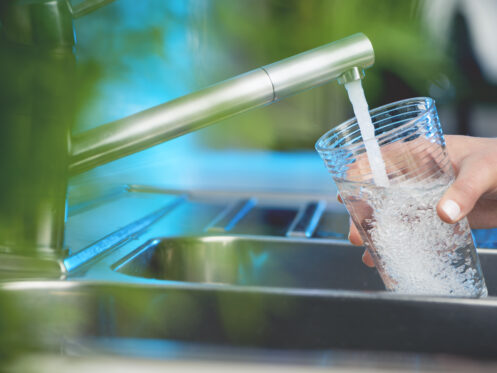Installing a whole-house water purification system is the best way to ensure optimum water quality in your Anaheim, CA home. However, taking good care of this equipment is equally important. Diligent maintenance keeps water purifiers working efficiently and minimizes the risk of many common water safety hazards. Check out the six maintenance tips that follow to get started.
1. Read Your Owner’s Manual and Your Manufacturer’s Warranty
As with all new home equipment, it’s important to read through your water purifier’s manual and warranty documents. When installing new whole-house purification systems, we show homeowners where these units are, how they work, and how to maintain and troubleshoot them. However, you’ll find this same information and more in all of your manufacturer-supplied documents.
Your owner’s manual provides detailed, model-specific instructions for ongoing maintenance. It will also tell you which tasks you can handle on your own and which steps should be passed on to licensed plumbing companies.
Your water purifier’s warranty lists the required maintenance for remaining warranty-compliant. It also details the potential missteps that could cause your coverage to be voided outright. Of these last, skipping annual maintenance, failing to change filters or have them changed, and attempting do-it-yourself (DIY) repairs are just a few.
2. Schedule Annual Whole-House Plumbing Inspections
The state of your plumbing system can have a significant impact on the efficacy of your water purifier. If your water supply pipes are leaky, damaged, or severely corroded, your water quality will decline immediately after water has left your purification system.
Although leaky pipes are always a problem, leaky supply lines are an even greater health and safety hazard. Leaky wastewater pipes let harmful pathogens out and leaky supply lines let them in.
During our whole-house plumbing inspections, we test water pressure at main supply lines and where they branch off. We also use other diagnostic tools and methods to assess the integrity of buried pipes and their likelihood of leaks.
Schedule Regular Water Quality Tests
Part of your annual whole-house plumbing maintenance is scheduling a water quality test. According to the United States Environmental Protection Agency (EPA), annual water quality testing is the best way to rule out lead contamination and other in-house contamination sources for municipally treated water. The EPA also recommends making water quality testing a priority when there are pregnant people living in the home, aging adults, residents with compromised immunity, or newborn babies.
3. Address Hard Water Issues
Whole-house water purification systems and water softeners are not one and the same. Although both are installed at main water supply lines and treat all of the water that enters buildings, they treat for vastly different issues. Whole-house water purification systems extract chemical contaminants that municipal water treatment systems cannot. Water softeners remove dissolved minerals like calcium and magnesium. Among other things, they prevent problems like hard-water buildups in faucet aerators, showerheads, and pipes, premature water heater failure, and poor dishwasher and washing machine performance.
If your water is excessively hard, it could cause your water purification system to fail prematurely. If you intend to install a whole-house water purification system in the future or have plans to replace your current one, you can combine this unit with a separate water softener or look for an option that performs both functions at once.
How to Know If You Have Hard-Water Problems
Hard water deposits small amounts of dissolved minerals on every surface it touches. These deposits diminish the diameters of pipe interiors. This leads to lower water pressure at all faucets and other fixtures. For instance, if the spray from your showerhead has declined or if you get a sputtering stream from your bathroom tap, you may have hard water.
The exterior of your fixtures could have chalky buildups of calcium and magnesium as well. Other signs of hard water include:
- Dingy-looking laundry
- Hard-water streaks or spots on dishes
- Dry skin and other frequent skin issues
- Increases in your water heating costs
- Poor-tasting water
In addition to testing for chemicals, water quality tests also determine water hardness.
4. Check and Change Your Water Purification System’s Filters
Performing filter changes is the most important part of maintaining whole-house water purification systems. These components have finite life spans and will eventually become overwhelmed. However, most whole-house water purification systems have more than one filter. Moreover, these components aren’t always easy to access.
In addition to reading the model-specific information on filter changes in your manufacturer’s warranty and owner’s manual, ask for an in-person demonstration during your next plumbing service. If your model allows for DIY filter changes, we’ll show you how to do it correctly. If it does not, scheduling regular maintenance service for your air purifier is the only way to stay on top of this task.
5. Schedule Annual Maintenance
Annual water purifier maintenance is a common requirement in equipment manufacturers’ warranties. We check and change filters, assess the integrity and functionality of water purifiers, and look for problems like loose connections and supply line leaks. We also check for environmental factors that might impact the safety of this equipment and the water that flows through it.
6. Replace Your Water Supply Pipes as Needed
Whole-house water purification systems extract chemicals and other contaminants that municipal water treatment processes do not. Many water purifiers also extract residual chemicals from the water treatment process itself, such as chlorine, chloramine, and fluoride. However, given that they are attached to main water lines and purify water before it enters homes, they don’t remove any of the contaminants that are introduced by in-building pipes.
Diligent maintenance of your water supply pipes is one of the most important parts of protecting your water quality. While wastewater pipes are slightly thicker and more durable than water supply lines, the two are often comprised of the same materials:
- Brass
- Copper
- Galvanized steel
- PVC
- Cast iron
Thus, if your wastewater pipes are showing serious signs of degradation, your water supply lines are likely in poor condition, too. In the right conditions, galvanized steel, cast iron, and brass pipes can last up to 80 years and copper pipes can last a full century. At best, PVC pipes will last 50 years, but some reach the ends of their service lives in half this time.
Factors like water pressure, water turbulence, soil quality, and natural corrosion all take their toll. PVC pipes are more vulnerable to environmental conditions than other materials. Staying on top of whole-house plumbing inspections and essential pipe replacements will ensure that your pipes aren’t offsetting the benefits of water purification.
This is also important for hard water management. Although groundwater is the greatest source of dissolved, hard-water minerals, aging pipes can cause hard water as well. Galvanized pipes installed before 1975 are zinc-coated. Over time, constant exposure to moving water wears this coating away and sets the stage for corrosion. When pipes are corroded, all new water that passes through them picks up dissolved minerals.
We help homeowners in Anaheim, CA optimize their plumbing systems for safety and efficiency. We offer outstanding plumbing repair, leak detection, and drain cleaning services. We also provide water heaters, water purification systems, sump pumps, and more. To schedule water quality testing, water filter maintenance, or a whole-house plumbing inspection, contact Splash Plumbing now!












